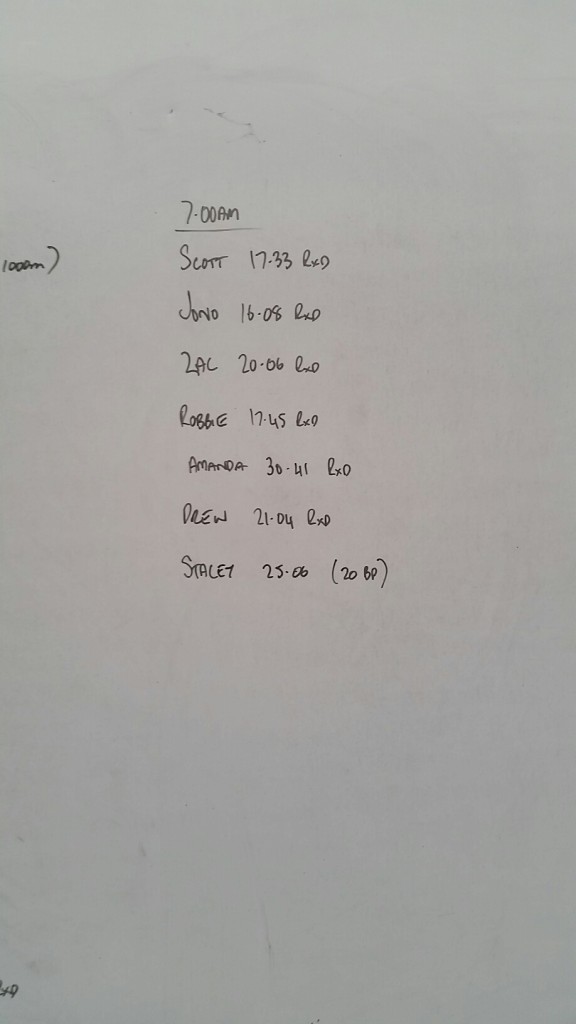*Yoga is on at 8:00am.
For time:
100m Farmers Carry 24/16kg
Run 800m
25 Burpee Pull-ups (30cm jump)
200m Farmers Carry
25 Burpee Pull-ups
Run 800m
100m Farmers Carry


COASTAL IN-BOX OPEN – LET’S HIT THIS TOGETHER!!!We make the CrossFit Open our own with Coastal IN-BOX OPEN- our community comes together for 3 weeks of competition, fun & community. You don’t want to miss it!! What is the CrossFit OPEN? TEAM CAPTAIN ANNOUNCEMENT: TBAGet your TEAM CAPTAIN NOMINATIONS to Marie asap. SIGN UP HERE – $30 Participation ($10 for Team captains to cover any costs + $20 event costs). Read below to learn more… Our goal at Coastal CrossFit Queensland is to educate and inspire you to become the best version of yourself. Competition helps with the ‘inspire’ part: the pressure to perform pushes you to train harder; the social boost of dozens of your best friends cheering for you will help you reach a higher plan. Heck, watching your teammates GO is inspiring!!!Every year, CrossFit HQ runs an event called “The CrossFit Open” (Be sure to read the link if you don’t know about it). Doing the Open our way…The goal of our IN-BOX OPEN is community participation-help one another push that little bit extra, have some fun and achieve together. Add in some light hearted banter and a party at the end – what more could you want?? For the past few years we have done the Open our way and have the best time doing it!!!For many of our members we’re not interested in finding out how fast you can exercise against 400,000 other people worldwide. We ARE interested in helping you push to new levels in fitness, level up your life, and get high fives from our Coastal family. Can we bring that worldwide thrill home? Can we deliver all the fun of competition without causing any anxiety attacks? We think so!! SIGN UP HERE – $30 Participation ($10 for Team captains to cover any costs + $20 event costs). COASTAL IN-BOX OPEN.The HOW?All registered athletes will be allocated to a team. We’ll divide you up into four teams, each with a Team Captain and an awesome team name.Individuals/Teams will earn points each week by:1. Participating (1 point per participant),2. Top three winners in Open division and Masters 50+ (1st – 3 points) (2nd -2 points) (3rd – 1 Point),3. Spirit (3 points) (by member vote)4. Best dressed (3 points) (by member vote). We will have a weekly and running IN-HOUSE SCORE CARDS.The Team with the highest TALLY after 3 weeks WINS!!! REGISTRATION/DRAFT MORNING –Saturday 15th February we will have our draft morning where teams will be allocated. We would love for everyone to be signed up prior to draft morning. TEAM ALLOCATION-We will allocate teams on DRAFT morning. Date – Friday 14 Feb – 4pm Registration will happen between now and February 14th. We want everyone participating. On Draft morning we will get together in person or join us on Facebook to watch your name be pulled from a hat. Unlike school, EVERYONE GETS PICKED. Then the Captains work hard to get you on board for the ride!! We want you to sign up this year; are you really going to say no to our awesome team captains? I don’t think so!!! BASIC RUNDOWNWe will complete one workout each week for three weeks (WOD released by CrossFit HQ). Workout times –WOD 25.1: Saturday 1st March & Monday 3rd March (all sessions)WOD 25.2: Saturday 8th March & Monday 10th March (all sessions)WOD 25.3: Final WOD- FRIDAY NIGHT IN LIGHTS 14th March (PM Sessions) & Saturday 15th Mar (Goal to get everyone through by Saturday) End of OPEN Party – TBA REGISTRATION – CROSSFIT OPENYou can also sign up for the Open the CrossFit Games Site to check your rank worldwide. Please note# This is a separate registration. HOPEFULLY WE HAVE CONVINCED YOU TO SIGNED UP….. NOW LET’S HAVE SOME FUN!!!

Introduction to Holistic Goal Setting for 2025 As we step into a new year, it’s the perfect time to set meaningful goals that encompass all aspects of life. Holistic goal setting ensures that you’re not just chasing achievements in one area but creating a well-rounded plan for personal growth, health, and happiness. In 2025, let’s focus on four key areas to create a balanced approach to success: Key Areas for Holistic Goals A Simplified Approach to Goal Setting To make the process approachable, focus on three levels of goals: Tips for Success Your Path to a Fulfilling 2025 By setting intentional, balanced goals, you can make 2025 a year of meaningful progress and growth. Whether it’s improving your fitness, building stronger relationships, or advancing in your career, this holistic approach ensures that every area of your life thrives. Publicly sharing your goals will allow our community to assist in keeping you accountable and working towards fulfilling your goals. I encourage everyone to share their goals in comments. We will be hosting an evening shortly to share/provide support in helping us work towards achieving our goals (date to be announced shortly). Here’s to a year of growth, resilience, and success! 🌟

We are excited to be expanding our Coastal CrossFit KIDS/TEEN program. TUESDAY & THURSDAY 3:30-4:15pm (Ages 5-13)WEDNESDAY 3:30-4:15pm (Ages 10+) – Note: Ages 10+ can also attend Tuesday & Thursday sessions. About our KIDS/TEEN Program: Our Coastal CrossFit Kids Program is designed to inspire a lifelong love of fitness while building strong, confident, and capable young athletes. We offer two tailored programs: Benefits of CrossFit for Kids: Each session is programmed to suit all abilities, ensuring every child is challenged while having fun. Whether they’re just starting their fitness journey or looking to take it to the next level, Coastal CrossFit Kids is the perfect place to grow, learn, and thrive.

A profound idea from a five-minute TED Talk by David Brooks (watch here) sparked a shift in how I think about life’s priorities. It introduced the concept of Resume Goals and Eulogy Goals—two distinct ways of defining success and fulfillment. Building on my previous article, Lifestyle Millionaire, which advocates for a balanced approach to life—physical health, mental and emotional well-being, relationships, financial freedom, self-improvement, quality nutrition, and leisure—this framework challenges us to consider not just what we achieve but how we are remembered. The Two Types of Goals Resume Goals These goals focus on external achievements: the skills you acquire, the accolades you earn, and the milestones you reach in your career. They’re the accomplishments that look impressive on paper but don’t necessarily define the essence of who you are. Eulogy Goals Eulogy goals reflect your inner character—the traits and values people celebrate when your life is remembered. They emphasize qualities like kindness, honesty, courage, and the positive impact you have on others. While both types of goals play a role in life, eulogy goals hold deeper significance because they shape the legacy you leave behind. Why Eulogy Goals Matter Dr. Seuss eloquently captured the essence of eulogy goals when he said:“To the world you may be one person; but to one person you may be the world.” This quote highlights the profound importance of how we touch others’ lives. Eulogy goals aren’t about fame or fortune—they’re about the love, kindness, and integrity that leave a lasting impact. While resume goals focus on building a life of external success, eulogy goals emphasize building a life of meaning and connection. They’re embodied in the moments when you go out of your way to help someone, show empathy, or stand by your values even when it’s difficult. Living with Eulogy Goals in Mind To align your life with eulogy goals, reflect on these questions: Living with eulogy goals means prioritizing relationships over recognition, integrity over ambition, and purpose over productivity. It’s about striving to be the kind of person whose legacy is defined not by what they achieved but by how they made others feel. A Legacy Worth Remembering In a world that often prioritizes resume goals, embracing eulogy goals takes courage. It’s a deliberate choice to live authentically, guided by the qualities that matter most. By focusing on your eulogy goals, you create a life that leaves a profound and lasting impact—one that truly honors the person you aspire to be. I am incredibly grateful to be part of a community that lifts each other up, challenges us to lead our best lives, and inspires us to become the best versions of ourselves. Together, we can create legacies worth cherishing.

Coastal CrossFit will be closed today for the Australia Day Public holiday.Have a great day with friends/family continuing to celebrate all that is wonderful about our country and the champions we are surrounded by. We look forward to seeing you all back on Tuesday.

